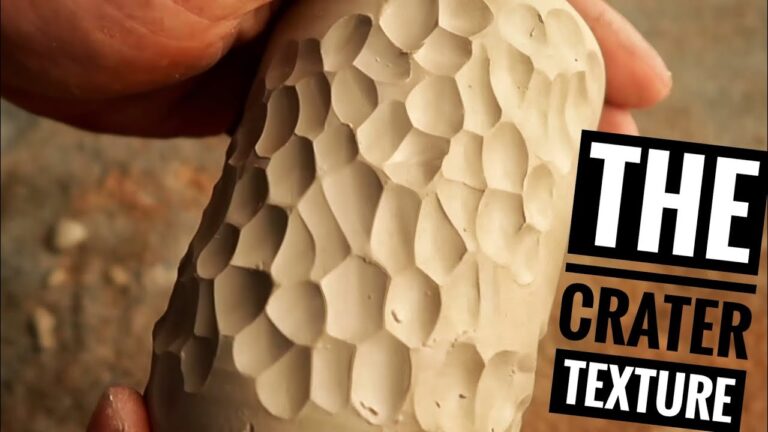Discover the art of pottery by exploring techniques for achieving natural textures. From hand-building to wheel-throwing, unleash your creativity and bring your pieces to life with unique finishes inspired by the beauty of nature. Whether you’re a beginner or seasoned artist, these methods will take your pottery to the next level. Join us on a journey of innovation and craftsmanship as we delve into the world of pottery and explore the endless possibilities of creating stunning textures.
How can texture be achieved in ceramics?
Looking to add some texture to your ceramic pieces? One of the easiest and most effective methods is to impress various objects into the clay. Whether it’s using pre-designed rollers or grabbing materials like gravel from your garden, the options for creating unique textures are endless. Simply roll or press the objects into a slab of clay and watch as your ceramics take on a whole new level of visual interest and tactile appeal.
What are three ceramic techniques used in pottery making?
In pottery making, there are three main ceramic techniques that artists commonly use to create their pieces. Wheel-throwing is a technique where clay is shaped on a spinning pottery wheel, allowing for precise control and symmetry in the final product. Slipcasting is another technique where liquid clay is poured into molds to create intricate shapes and designs. Handbuilding is a technique that involves shaping clay by hand, using techniques like pinching, coiling, and slab-building to create unique and personalized pieces.
Each of these techniques is best suited for different types of clay, depending on the desired outcome of the pottery piece. Wheel-throwing is often used with stoneware or porcelain clay, which are both durable and ideal for functional pieces like cups and bowls. Slipcasting works well with earthenware clay, which is more porous and better suited for decorative pieces like vases and figurines. Handbuilding can be done with a variety of clay types, allowing for endless possibilities in design and form.
When it comes to finishing a pottery piece, the type of glaze used can greatly impact the final look and feel of the piece. Satin glazes provide a smooth and slightly matte finish, perfect for adding subtle color and texture to a piece. Gloss glazes create a shiny and reflective surface, enhancing the colors and details of the pottery. Matte glazes offer a soft and understated finish, ideal for pieces that want a more muted and natural look. Choosing the right glaze for your pottery piece can elevate its beauty and showcase the craftsmanship of the artist.
What are the 3 main techniques in hand pottery?
Discover the art of hand pottery by mastering the three main techniques: pinching, coiling, and slab building. These methods allow you to create intricate and unique pottery pieces with your own hands. With practice and dedication, you can transform clay into any form you desire, unlocking endless possibilities for your creativity.
By learning pinching, coiling, and slab building, you gain the foundation to craft a wide range of pottery items. Whether you’re a beginner or an experienced potter, these techniques provide the versatility needed to bring your artistic visions to life. Embrace the tactile nature of hand pottery and explore the endless potential of clay as you hone your skills in these fundamental methods.
Creating Organic Beauty: Pottery Texturing Methods
Pottery, a time-honored art form, offers endless possibilities for creating organic beauty through various texturing methods. By experimenting with different techniques, artists can achieve unique and captivating textures that add depth and character to their pottery pieces. From hand-building to wheel-throwing, each method presents its own set of opportunities for artists to explore and express their creativity.
One popular method for creating organic beauty in pottery is through the use of natural materials such as leaves, twigs, and shells. By pressing these items into the clay, artists can achieve intricate patterns and textures that mimic the beauty found in nature. This method allows for a seamless integration of organic elements into the pottery, resulting in visually stunning pieces that capture the essence of the natural world.
Another effective way to create organic beauty in pottery is by utilizing carving and etching techniques. These methods allow artists to carve intricate designs and patterns directly into the clay, adding a unique and personal touch to their pieces. By carefully etching and carving the surface, artists can create visually striking textures that enhance the overall aesthetic of the pottery, making each piece a true work of art.
Harnessing Nature: Advanced Pottery Texture Techniques
Unleash your creativity with advanced pottery texture techniques that harness the beauty of nature. From intricate leaf imprints to delicate floral patterns, explore the endless possibilities of incorporating natural elements into your pottery designs. Elevate your craftsmanship and create truly unique pieces that reflect the organic beauty of the world around you. With these innovative techniques, you can transform ordinary clay into extraordinary works of art that capture the essence of nature in every texture. Embark on a journey of artistic exploration and let nature be your ultimate muse in the world of pottery.
By incorporating various pottery techniques such as sgraffito, carving, and impressing, artists can effortlessly create stunning natural textures on their ceramic pieces. These techniques not only add depth and character to the artwork but also allow for a unique and personalized touch. With a little experimentation and practice, artists can master these techniques and elevate their pottery to new levels of creativity and craftsmanship. So, whether you’re a beginner or experienced potter, don’t hesitate to explore these methods and let your imagination run wild to achieve truly exceptional results in your ceramic creations.



